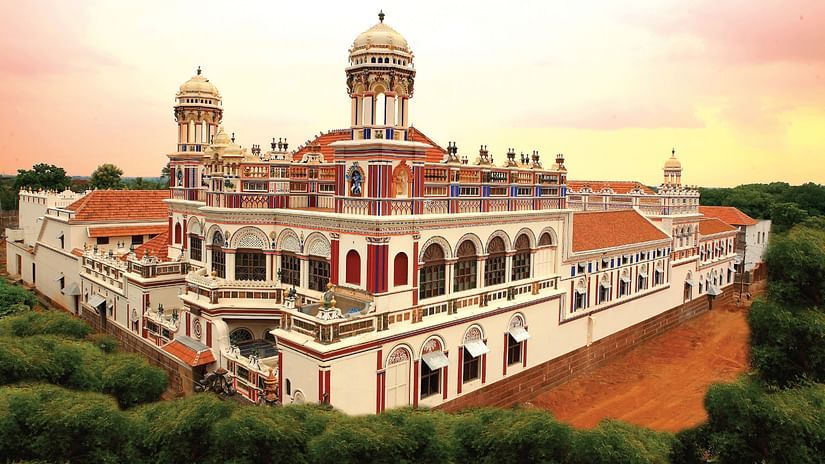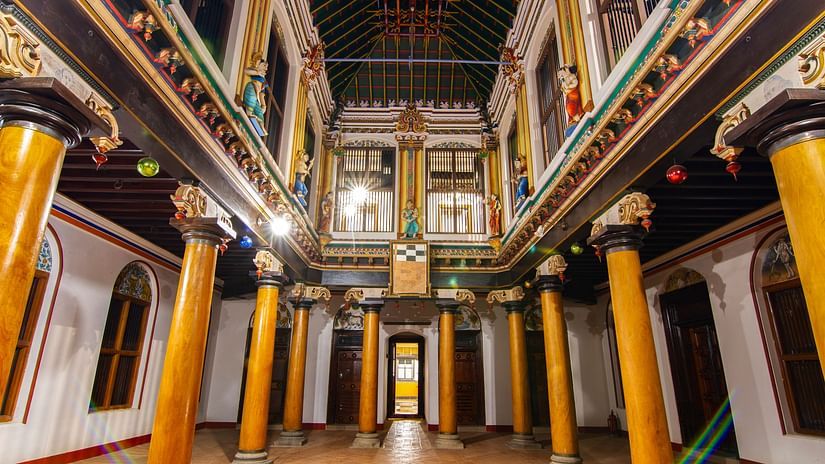

Chidambara Vilas Overview
Chidambara Vilas is 118 year old heritage Chettiar home that provides an authentic showcase of the luxurious Chettinad lifestyles of the last century.
Authentic restoration
The luxury is truly in the details, made possible through a 3 year restoration effort by the Sangam group which manages this heritage property. You can now experience one of the best examples of authentic Chettinad architecture, furniture, glasswork, tile work and paintings.
Beautifully recreated rooms
The rooms have been recreated and restored to the smallest details. At the same time the rooms have been subtly enhanced with all luxuries and amenities to offer a personalized experience that gives the best of both worlds, a full century apart.
Cuisine
Savour the world famous Chettinad cuisine through three unique dining experiences at Chidambara Vilas – Interactive, Experiential and Fine Dining.
Indoor and outdoor activities
Enjoy a complete Chettinad experience through the custom designed indoor and outdoor activities. Relax in the international standard swimming pool and lounge area within the property.
The History
The history of Chidambara Vilas begins in 1884 with the members of a powerful Chettiar family leaving for abroad. Construction on the mansion was started on a one acre plot which was gifted by the Maharaja of Pudukottai. It took 7 years from 1897 to 1904 to complete the house at a princely sum of 7 lakhs over 120 years ago. The wood was imported from Burma, marble tiles and granites from Italy, chandeliers, lights and mirrors from Belgium.
Restoration by Sangam Group
Today, Chidambara Vilas is projected to visitors as an authentic experience of the rich Chettinad heritage, as a result of the restoration project conceived by the Sangam group who manage the property. The restoration took 3 years, which is almost half the time it took to build the actual home, to ensure that the authentic heritage of the house is preserved.
Interiors
Standing apart through unique details
Chidambara Vilas is an exquisite specimen of Chettinad Houses. As with all things Chettinad, the luxury was in the details and powered by the financial influence of the merchant. The house was built over 100 years ago at the peak of Chettinad dominance and the opulence of the era can be felt in every aspect of its interiors. Built at the time of the British Raj, Chidambara Vilas fits the format of the perfect Chettinad house – an amalgam of traditional and Western design sensibilities. For its sheer details, Chidambara Vilas boasts interiors that stand out from among the other houses in the region.
Mugappu and Paadasalai- Reception and lobby area
The Mugappu is the reception area at the threshold of the entry to Chidambara Vilas. A key element of the reception is the Kallupetti which is the accountant’s desk. The origin of this desk hails back to the days when the Chettiars were running finance and banking operations in the last century. A striking element is the numerous pillars which are done up in materials like wood, granite, terracotta and decorated by ornate woodwork.
As you enter the house, you will be led to the Mugappu which is the reception area at the threshold of the entry to Chidambara Vilas.
The lobby and reception were decorated opulently to greet and impress the visitors. The main door to the house is situated here and displays intricate carvings of Gods and Goddesses, in mythical contexts and situations.
The carvings on the door are as sacred as the carvings used in temples. As the doors open you have a view that runs through the various courtyards that line the entire length of the house.
The Paadasalai towards the sides of this area showcase Belgium glass decorations, Italian tiles, Victorian furniture and chandeliers. Typically these rooms were used to conduct business and entertain visitors, while entry to the rest of the house was restricted to family.
A striking element that catches your eye is the numerous pillars which are done up in materials like wood, granite and terracotta and decorated by ornate woodwork. The pillars are designed to convey strength, power and opulence.
Valavu - The Courtyard
The courtyard following the Reception and lobby is called the Valavu. The courtyard is framed with rooms on two sides. The doors to these rooms are intricately carved with auspicious images of Gods and Goddesses. Each married male member of the family is given one of the rooms surrounding the Valavu or upstairs.
The courtyard following the reception and lobby is called the Valavu. It is framed by pillars on a raised platform and intricate carvings on the roof borders. The courtyard boasts of an open design which allows for ventilation and sunlight.Today this area is popular with visitors as a lounge area where they can relax and watch the rain fall within the house through the open courtyard.
The courtyard is framed with rooms on two sides, one side is the Paadasalai and the other side leads to the dining area.
The doors to these rooms are intricately carved with auspicious images of Gods and Goddesses. Today many of these rooms have been converted to puja rooms or storage of valuables from each family.
The open courtyard design provides ventilation and breeze to all the rooms, which is important because this region generally experiences high temperatures. Another design factor in the courtyard was the methods of rainwater harvesting practiced. Huge vessels were placed to collect rainwater from all the corners of the courtyard and the water was used for cooking purposes. The house is designed so that the rest of the rain water is collected and sent to the pond through tunnels. The water from the pond was then used for agricultural and domestic purposes.
Bomma Kottagai
Bomma Kottagai literally translates into doll house, and this is reflected in the intricate carvings and installations of dolls in this hall. The use of the hall hails back to the Chettiar tradition of inviting neighbours and relatives to pooja and lunch during the time of the festival of Golu. During this festival several intricate dolls were displayed to the visitors in the hall and this tradition has translated into the use of dolls in decorating the hall.
The Bomma Kottagai at Chidambara Vilas is one of the best preserved and unique examples among Chettinad mansions. The level of details in the halls ranged according to the tastes and abilities of the owners of the mansion.The artwork stands out in terms of the execution and innovative features like three dimensional carvings which meant that each doll was created in its entirety and not just the visible frontage.
Visiri Hall
The Visiri hall was reserved for the women in the family. The hall has now been converted into the experiential dining hall which serves authentic Chettinad leaf meals. The hall is decorated with paintings depicting mythical scenes from the Hindu epics Mahabharata and Ramayana. The paintings were done using organic colors created through combining various natural dyes and elements. These dyes and organic elements were ground together to create the various shades and colors. This hall is also known as Panka Hall. Before the use of electricity the Fan (Panka) was operated manually. Exquisite chandeliers which used candles are also seen in the hall.
Exteriors
Opulent Exteriors
As a result of the specific requirements and multiple influences, the exterior design and layout of Chidambara Vilas is an astute mix of the traditional, the practical and the opulent.
Golden age of Chettinad architecture
Chidambara Vilas was built at the prime of the Chettiar era, when the grandest Chettinad homes were built. As a result it represents one of the finest examples of Chettinad homes in terms of the scope of architecture, interiors and detailing.
Unique exterior features
The exterior design that stands apart with several distinguishing features, primary among which is the minarets and towers that adorn the heritage home. The minarets provide a beautiful view of the town and adjoining paddy fields. The Thirumayam fort is also visible from the towers.
Exquisite detailing
Beautiful carvings featuring gods and mythical scenes from the Hindu epics decorate the exteriors of the house, particularly the entrances and the doors.
Amalgam of colors and influences
The exterior design stands out by the use of liberal amount of colors, which stands out against the white background. The high windows are stylistic elements from the European influence. The exteriors are a mix of art deco, South Indian and colonial styles. The mix of colors and styles is difficult to achieve and is unique to Chettinad architecture.